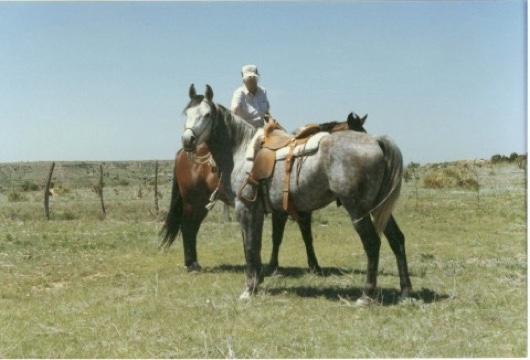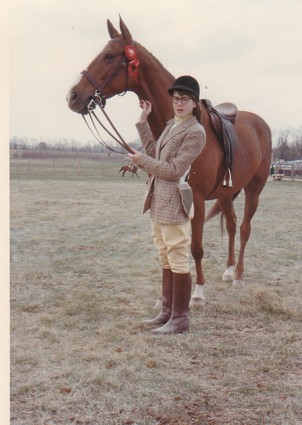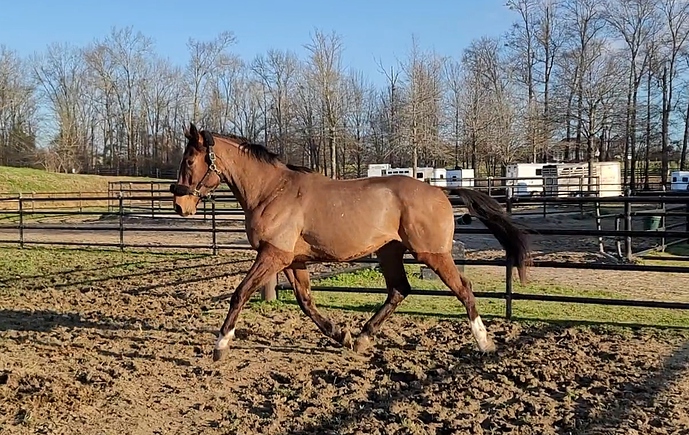I am politely begging you to share some photos.
So one thing I don’t know if anyone mentioned ( I may have missed it) is that we ride a lot differently now, and how we ride and make our horses work can really effect their soundness and even body shape.
If you watch videos or see photos of dressage from the mid 20th century, it’s, in general, not good. There’s a really interesting documentary on it out there somewhere. But essentially, the way people asked horses to move wasn’t very conducive to true impulsion, strength, and long term soundness. And these were the best of the best at that time. So if the excellent riders are riding their horses inverted around the arena, the rest probably aren’t doing much better.***
Jumping is the same. We sat down on those backs, yanking the face, for a long time.
So I do wonder how much that could contribute to how horses look and act today vs the days of the past. Look at photos of horses before they start dressage training vs when they are at high levels; they won’t even look like the same animal.
*** yes I know there are definitely riders that truly were masters at that time that I could not even get close to being as good as today. But if you look through the photos or video, you will see riders at big events winning with their horses looking like a confused giraffe. If I tried to ride like that today in a GP I’d be laughed out of the arena.
This was a registered arabian I had, about mid 70’s.
He made a nice ranch horse, but didn’t get along so well turned out with the quarter horses and TBs we had, kept picking at them, always looking for someone to play rough with.
I only had him for a year or so.
He came from a California breeder, his sire a halter type arabian:

Showjumping - look at, and I don’t mean this as a slight to the whole Snowman story, Harry De Leyer (though I believe I’ve seen it mentioned somewhere that he sometimes hammed it up specifically on Snowman and I believe there’s video either in the documentary or elsewhere online of De Leyer riding a different horse probably in the 1970s and his equitation isn’t nearly as eyebrow raising. So he either improved over the years or yes, hammed it up a bit on Snowman specifically or a combination thereof) for example. Or look at anything pre-Caprilli/Forward Seat, whatever. The whole “feet propped out in front, leaning way back” position was considered correct.
Coming late to the conversation…
I wouldn’t call that horse a heavy weight Thoroughbred type. He looks more like a heavy weight Hunter type and is probably a crossbred.
The picture below is from the mid-1960s–a TB mare who was born in 1959. She foxhunted, horse showed (including Devon and MSG) and was considered to be a lovely TB type at a time not long after that book was written. This mare was the TB “norm” for the 50s-60s. If anything she is lighter framed than the TBs my husband and I breed and race today.

Those glasses, coat, hair, boots? Perfection. What an awesome photo.
Those glasses, coat, hair, boots? Perfection. What an awesome photo.
Truthfully I can’t look back at myself without cringing a bit–but the mare was lovely. (I also want to go back and run up my stirrups!)
Thank you, I’m glad you like the picture. 
Thanks for correcting me re: Shepherds & Labs.
So so sad what breeders have done to those Hock-walkers and Flabs.
And what they’ve done to the brachycephalic dogs is just criminal. Shame on them!
If I had been showing with you (also a 60s Hunter kid - but nowhere near as famous locales) I would have been pea-green with envy.
I had my Aunt’s black wool huntcoat - circa 1930-something - and off-the-rack black Dehner boots.
I soooooooo wanted a tweed or madras (Summer) coat & cordovan or Newmarket boots, like the Cool Kids had.
I did have the velvet huntcap (bow in back) & dork glasses*
*that I told my Mom I couldn’t wear riding “for safety reasons”,
She wasn’t horsey, so that flew 
@2DogsFarm, the tweed jacket and the cordovan boots had also come to me from my mother. It would be a couple of years before I actually had my own stuff. And I’m quite certain I never managed to be a Cool Kid.
I had to wear my glasses, dorky or not, otherwise I couldn’t see the jumps. 
The “Thoroughbred type” in the photo looks to me like what used to be called a heavyweight hunter. A term I haven’t heard in decades.
I think he’s a nice, solid looking horse. I like the ears forward, bright look. It also looks like they have some working pens in the background. Maybe somewhere out west?
I remember the heavy hunter division!
As for big, strong, solid TBs I own 2. One I have had since he was 5 and he is now 26. The other is 5. People often assume my young TB (pictured) is my ISH because of his outstanding bone. He is 17.2 and is the kindest horse with the easiest personality and is athletic beyond words. You could not convince me that he is less of a horse than the one in the original photo from the first post.
I do remember a time when it was ok to have a serviceably sound horse. Or “sound enough”. Or “not limping horribly”. Now, I’ve seen people euthanizing sound-appearing horses based on radiographs.
So there’s that.
Bone doesn’t always equate to soundness. Sometimes it helps, but I’ve seen an awful lot of drafties and draftx with sidebone, ringbone and other spavins (do they still use that term anymore? I don’t even know lol).
I think generally speaking, people don’t ride as long and many ride confined to the arena so you can have a lighter, more purpose-bred horse. In the hunt field and in the “using” horses I see plenty of bone. But fewer and fewer people hunt, drive carts, or really use their horses. And as we change what we buy, breeders change what they breed.
I do think that it’s a matter of “fingers pointing back at us”. As long as us, the horse-owning public, continue to perpetuate the “only a purpose-bred horse is suitable for the job” and we don’t look for the jack of all trades types of horses we have only ourselves to blame as they dwindle and disappear. Trainers need to stop thinking their ammy-owner clients need a huge moving warmblood to compete at 2’6" or training level dressage, and we need to value the horse that can do a dressage test, work some cows, and go on a trail ride without dumping it’s amateur owner who likely sits at a desk 5 days a week and doesn’t have the fitness to stick with it.
It’s us. We’re the problem. Not the horses.
I came back to this thread and read a post quoting the original and now I’m wondering, and I dunno how this just occurred to me, but then again, I also wasn’t around back in Ye Olde Days, so that’s probably part of it. Anyhow, I’m thinking maybe:
- “Heavy” used as a descriptor of the horse DID mean “heavyweight hunter” as in the type of horse/type of class.
AND
- Maybe “thoroughbred” was used to denote the horse being purebred - I think some old-timey people in certain regions would use the term “thoroughbred” to describe a purebred animal, broadly. Though I’ve never really heard it used in that manner with horses.
EDIT: “didn’t” to “DID.”
Trainers need to stop thinking their ammy-owner clients need a huge moving warmblood to compete at 2’6" or training level dressage, and we need to value the horse that can do a dressage test, work some cows, and go on a trail ride without dumping it’s amateur owner who likely sits at a desk 5 days a week and doesn’t have the fitness to stick with it.
Now - I don’t actively ride at the moment and when I was actively riding I wasn’t a hunter/jumper person (aspiring eventer who was barely learning to jump when life got in the way) but…is it all on the trainers? I’m not saying it’s not but, what are the judges rewarding in the show ring, also? Are the judges rewarding the huge moving warmbloods even in a 2’6 or training level dressage test? I’m not saying across the board, either, but if it’s more common for someone to succeed on a huge-moving warmblood vs. an all-around horse, well.
(That said - I didn’t grow up riding fancy either. Grew up at a backyard western barn riding QHs or QH crosses, first horse I owned was an OTTB, switched to English when I was 18 b/c the OTTB was never gonna be a western horse. OTTB passed away and I ended up briefly owning a palomino of indeterminate breeding - best guess anyone had was QH x (maybe) Saddlebred - he wasn’t gaited but he kind of had the tail position of something that might be gaited and someone I knew then swore he had ears like a saddlebred if that even makes sense. I’ve sat on a grand total of two warmbloods, one was an Oldenburg/Trakehner cross I rode maybe once, and the other was a Trakehner I rode in lessons when I finally got to a good barn.)
I’m not saying it’s not but, what are the judges rewarding in the show ring, also? Are the judges rewarding the huge moving warmbloods even in a 2’6 or training level dressage test? I’m not saying across the board, either, but if it’s more common for someone to succeed on a huge-moving warmblood vs. an all-around horse, well.
I don’t think so in the 2’6". There are some dressage judges with a bias, but most don’t have one. I do know a significant number of trainers who buy too much horse for their amateur owner, and then have someone else schooling and showing the horse. That, to me, is sad.
I do know a significant number of trainers who buy too much horse for their amateur owner, and then have someone else schooling and showing the horse. That, to me, is sad.
Don’t get sucked into thinking that’s an accident. It sucks for the amateur owner, but it’s very rewarding for the professional. I see it all the time here. I’m adjacent to several nice event barns and have peripherally witnessed the resident trainers cycle through countless unsuitable horses for their amateur riders. The horses keep getting fancier and fancier, and the pro rides them more and more. It’s hardly a mistake.
Don’t get sucked into thinking that’s an accident. It sucks for the amateur owner, but it’s very rewarding for the professional. I see it all the time here. I’m adjacent to several nice event barns and have peripherally witnessed the resident trainers cycle through countless unsuitable horses for their amateur riders. The horses keep getting fancier and fancier, and the pro rides them more and more. It’s hardly a mistake.
Oh I agree - definitely not a mistake. Just super sad for the owners.

